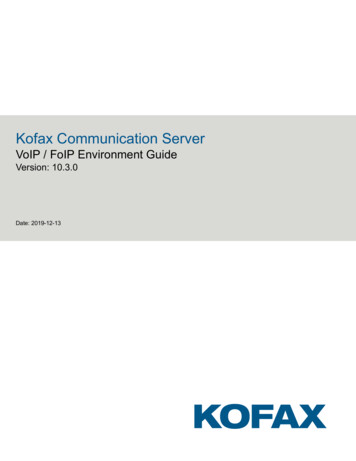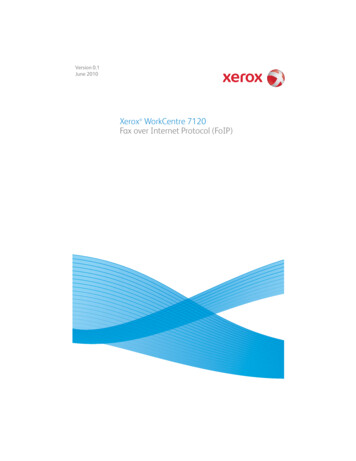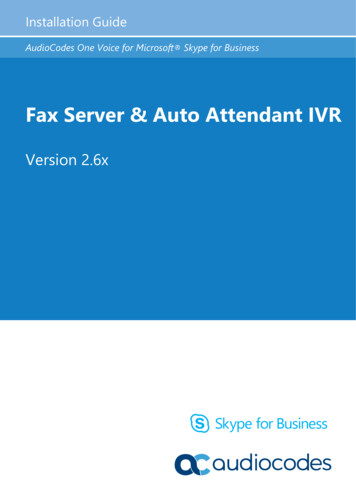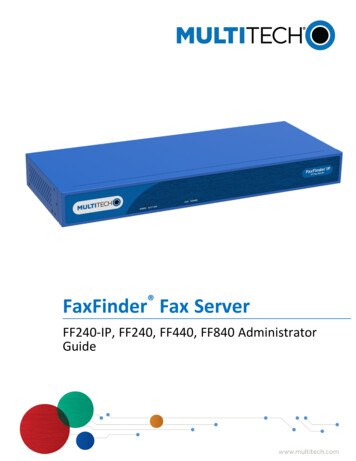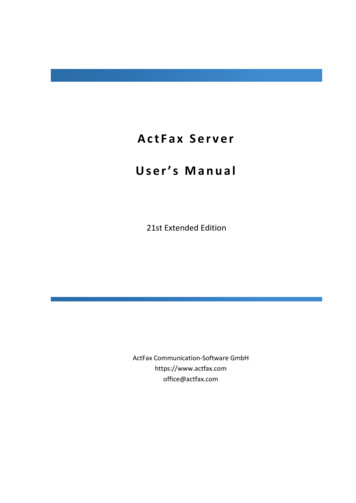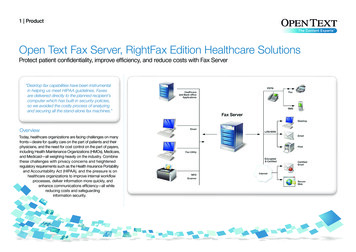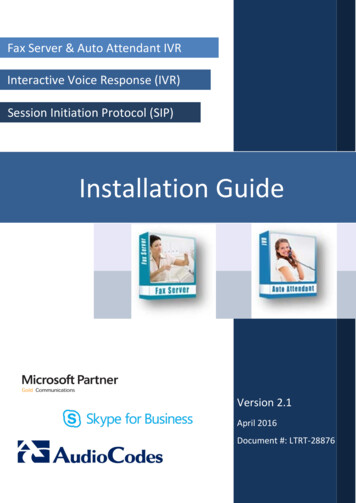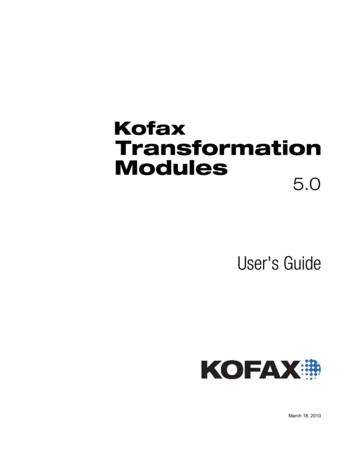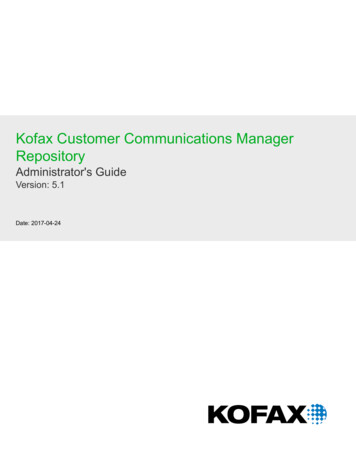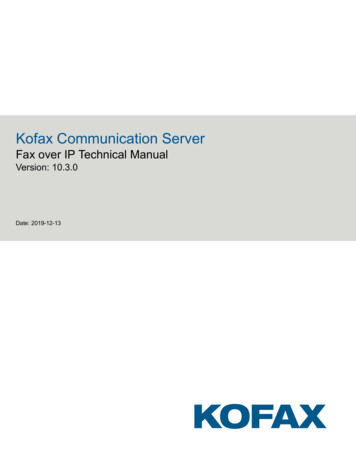
Transcription
Kofax Communication ServerFax over IP Technical ManualVersion: 10.3.0Date: 2019-12-13
2019 Kofax. All rights reserved.Kofax is a trademark of Kofax, Inc., registered in the U.S. and/or other countries. All other trademarksare the property of their respective owners. No part of this publication may be reproduced, stored, ortransmitted in any form without the prior written permission of Kofax.
Table of ContentsPreface.7Related Documentation. 8Chapter 1: Introduction. 9Voice and Fax over IP. 9Kofax Solution.9Use Cases. 10Installation with Kofax Communication Server.10Standalone Configuration. 11International Standards and Recommendations. 11IP Infrastructure Requirements.11Compatibility.12Unicode Support. 12Chapter 2: Installation. 13Prerequisites. 13Setup.15Personal Firewall Settings. 18Standalone Installer (FoIP.msi). 19Uninstalling KCS FoIP. 20Reboot Warning When Upgrading FoIP on Windows Server 2008. 20Upgrade from Older Releases. 21Upgrade from KCS FoIP 3.11.xx – 3.18.xx (KCS 9.0 – 9.2).21Upgrade from KCS FoIP 3.06.xx (KCS 8.2). 21Basic Configuration.21General.22List of Call Peers. 22Advanced Configuration. 23VoIP/FoIP Network.23Voice.26Fax. 27H.323 Signaling.28SIP Signaling. 29SSL Certificate. 31HTTP. 32KCS Integration.333
Kofax Communication Server Fax over IP Technical ManualStorage Settings. 34Advanced. 34Saving Configuration. 36Running FoIP in a Console Mode. 37Policy-based Quality of Service. 38Chapter 3: Web Portal. 44Call Peer Statistics. 45Send Fax via Storage. 46Sending in Loop-Back Mode. 47Fax Header Line. 48Fax Storage. 49Maintaining Fax Storage.49Inbound Messages.50Outbound Messages.51Chapter 4: Integration with KCS. 53Installation of Fax for KCS.53Step 1: Set Up TCOSS Server for FoIP. 53Step 2: Set Up FoIP.54Step 3: Verify Installation.54Step 4: Set Up Call Peers. 55Installation of Message Wait for KCS. 55Step 1: Configure KCS FoIP. 56Step 2: Configure CallManager and Test Message Waiting. 56Step 3: Create Services and Events in TCfW. 56Message Wait via SIP Notify (RFC 3842).57Installation of Voice for KCS. 57Install Voice Server.57Configure Voice Support in FoIP.59Enable Voice in the UFI Channels. 59Test the First Incoming Voice Call. 60Leave a Messages via Telephone.60Test Outgoing Voice Call with TC/Player. 60Unique Single Number Support. 61Hints. 62Supplementary Services.62Call Diversion (Redirecting Number).62DTMF Reception.64DTMF Generator for Two-Stage Outbound Dialing.644
Kofax Communication Server Fax over IP Technical ManualCall Transfer. 65Configuration Hints. 65Setting Own Calling Party Number. 65Fax on Demand. 66High Availability Support.66SIP Registrar and H.323 Gatekeeper. 73Behavior If an Incoming Call Is Rejected.74FoIP and Internet Telephony Service Providers.74V.34 Fax.75Support Variable Gateway IP for Outgoing Calls. 76Support of Static NAT.77Endpoint Name. 78T.38 vs. G.711 Pass Through Fax. 78T.38 Redundancy. 79Encryption of VoIP/FoIP Network Traffic. 80Voice Prompts.87Multiple FoIP Instances. 88Configuration Values.88UFI Channel Configuration. 88Description of UFI Specific Configuration Lines.92Tracing Possibilities in FoIP. 93Log Entry Filtering. 95Chapter 5: Migration to KCS FoIP.97Migration from KCS Line Server Model 305.97Migration of FoIPv2 (XCAPI).98Migrate TCOSS 7.80.04 with XCAPI 3.03.36 (H.323) to FoIPv3. 98Roll Back from FoIPv3 to XCAPI. 98Feature Comparison of FoIPv2 and FoIPv3. 99Migration of Message Wait via H.323.99Step 1 – Configure KCS FoIP.99Step 2 – Verify New Message Waiting Indication Functionality. 100Step 3 – Change the Prefix of Message Waiting Services. 100Step 4 – Update Arr99 File. 101Step 5 – Disable Old Message Waiting. 101Migration of H.323 Voice Engine. 101Step 1 – Reinstall KCS Server Package. 102Step 2 – Update Registry.103Step 3 – Configure KCS FoIP.1045
Kofax Communication Server Fax over IP Technical ManualHints. 104Feature Comparison. 104Chapter 6: Administration. 105Errors Codes in TCfW.105Two-Character TCOSS Error Codes. 105Additional Error Details.107Error Codes in FoIP. 107Error Categories.107Error Codes.109Connection Level. 117Event Log Entries. 118Chapter 7: Development Tools. 119Send Fax in Real Time. 119T.38 Player.120Prepare the T.38 Fax Stream to Replay. 121Initiating a Call. 122Showing Current State of the Call. 123Interrupting a Call. 124Fax Replay Limitations. 125T.38 PCAP Converter. 125Test Server.126Chapter 8: Web Service Functions. 127Chapter 9: Specifications. 128Supported TIFF Options.128How to Create a TIFF File for Faxing.128Microsoft Office Document Image Writer. 129KCS Printer Driver. 129TCIMG32.130Chapter 10: Acknowledgments.1316
PrefaceThis document describes Kofax Communication Server Fax over IP (FOIP) solution (Using IP Call Control:V3.03). It is mainly intended for system administrators responsible for installing and configuring FoIP andVoIP in their environment.7
Related DocumentationThis document refers to the following documentation: Environment Guide - Platform System Manual Line Server Model 305 PBX documentation (PBX Integration Technical Manual and PBX Requirements Technical Manual) TCOSS Application Module Manual TCOSS Configuration Manual TCOSS System Manual TC/FoIP Tracing Technical Manual Voice Server documentation (Voice Platform Technical Manual, Voice xSP Integration TechnicalManual) VoIP / FoIP Environment GuideThe full documentation set for Kofax Communication Server is available at the following ts/en US/KCS/10.3.0-SihMvq5oti/KCS.htm8
Chapter 1IntroductionThis chapter describes fax and voice over IP solutions in general, the architecture and use cases of KofaxCommun
The fax over IP solution communicate with the H.323 or SIP network. It supports FoIP using T.38 recommendation, FoIP G.711 pass through mode and VoIP. Kofax Communication Server Fax over IP is composed of the following components: FoIP core Web interface:

